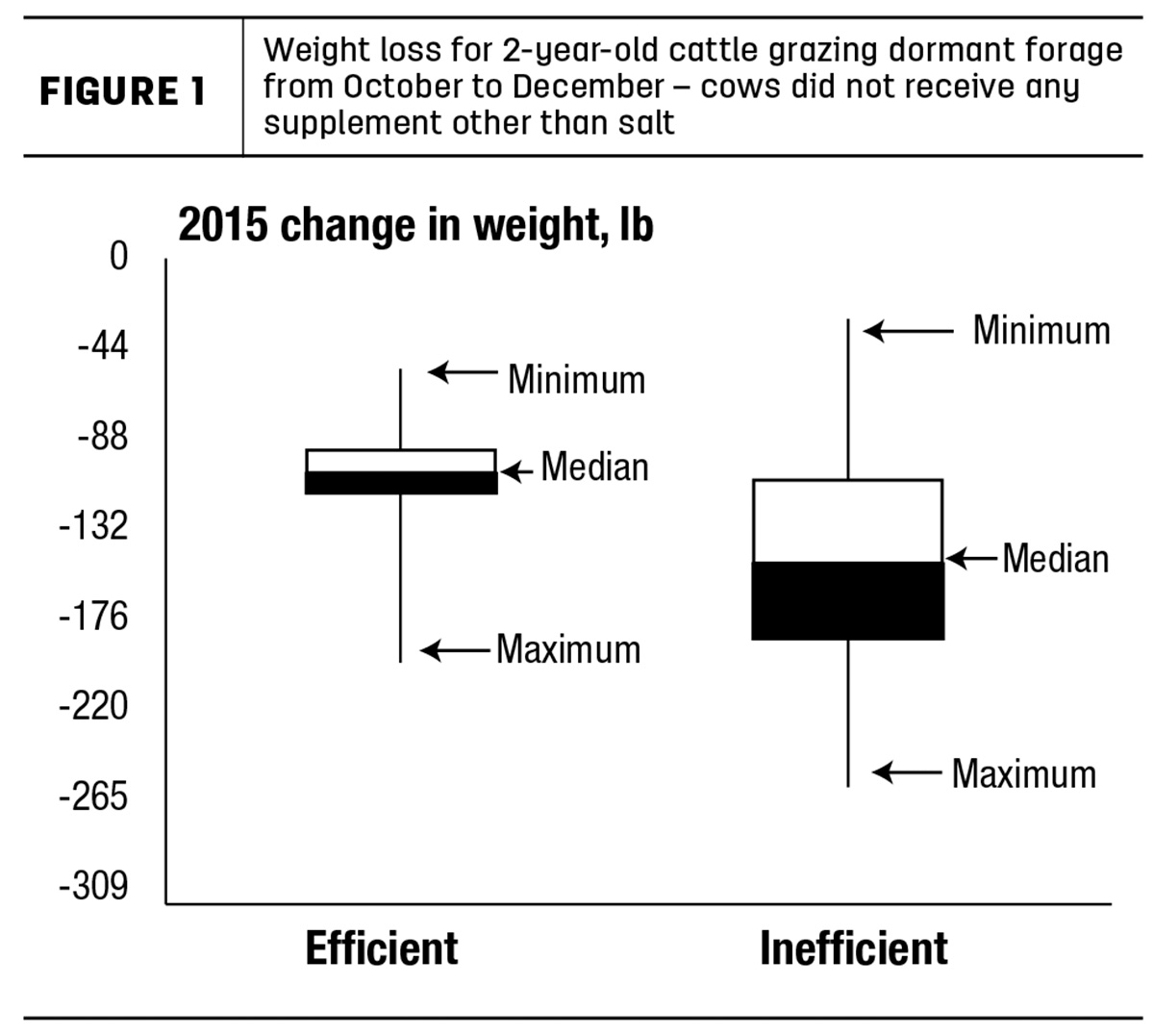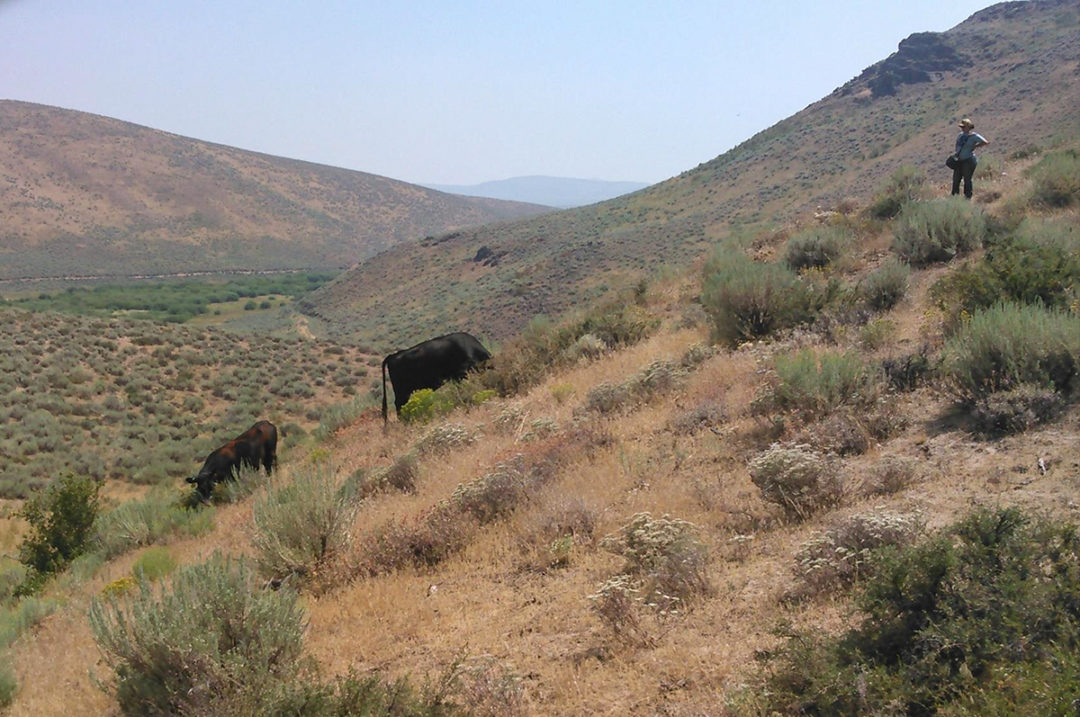Over the past decade, the importance of better understanding our cattle’s grazing behavior and impact on rangelands has become increasingly important. With the increasing size of finished cattle, the size of breeding cattle must also grow to create those larger-framed cattle. However, there must be recognition that a larger-framed cow and calf will need greater feed resources, but the amount of available grazing and rangeland is constant and, in some areas, shrinking. Because of this, it is more important than ever to understand the feed efficiency of our cattle and their impact on the environment.
Efficiency, simply put, is output divided by input. An example of cow herd efficiency could be: You put a herd of 50 pairs into a 200-acre pasture; we will call this Herd A. In a separate pasture, you put another herd of 50 pairs; we will call this Herd B. When you wean and weigh calves at the end of grazing season, the calves from Herd A weigh, on average, 50 pounds more per head than Herd B. So, you might say Herd A was a more efficient herd. But aren’t there a few variables missing? What variables could impact why one group weighed more at the end of the grazing season than the other?
In a cow herd grazing a native-range pasture, there is a multitude of reasons why one herd might be more efficient than the other. The short list could include genetics, starting weight, forage quality and quantity, terrain and stress on the cattle. When you get even more specific, you can look at individual cow variability, such as individual efficiency. To investigate this question further, researchers have developed a way to identify efficient or inefficient cattle in the feedlot using residual feed intake (RFI). Using specialized equipment, cattle can be compared with respect to RFI, which is expressed as the difference between expected feed intake (based on bodyweight and growth) and actual feed intake. Cattle with negative RFI scores consume less feed than expected and are classified as more efficient, while cattle with positive RFI scores consume more feed than expected and are classified as inefficient. However, most studies to date have looked at RFI during the post-weaning/backgrounding phase. Not many researchers have tested RFI in mature beef cows.
A study in Idaho was designed to determine whether 2-year-old cows differing in RFI would differ in forage intake and digesta kinetics (forage passage rate, gastrointestinal tract size, gastrointestinal tract residence time, energy intake and harvest efficiency). Prior to the study, yearling heifers were evaluated for RFI and classified as efficient or inefficient. The following year, as bred 2-year-olds nursing their first calf, they were evaluated for their grazing behavior, forage intake and digesta kinetics. Research samples were collected during midlactation in mid-June and late lactation in August. To determine forage intake and digesta kinetics, the cows were given a one-time pulse dose of an alkane marker, and over the four days following the dosing, fecal samples were collected. Data from the fecal analysis allow researchers to calculate estimates of fecal output, gastrointestinal tract size, forage passage rate and forage residence time. Coupled with an estimate of forage indigestibility, forage intake can be estimated from fecal output of the alkane marker. The results of this mentioned study were not completed at the time of this publishing. However, these results will help determine whether RFI in the testing environment of a feedlot carries over to efficiency on the range.
But why does this matter to grazing cattle? For Western producers, cow herds are typically on range from April to October with the hopes of some fall and winter grazing when possible. In a setting like this with limited resources – especially during drought years like we have seen recently – a cow that can better utilize the forage resource is very desirable. It is important to also consider that cattle in a range environment are consuming a complete roughage diet. A roughage diet takes cows longer to digest than if they are on a higher-concentrate diet. Because of this, it is important to consider the effect that changes in diet will have on the efficiency of an animal. A slower digestive tract might be able to extract more nutrients from the digesta, therefore allowing the animal to consume less but better utilize the ration available to her.
Other studies have shown that female cattle that tend to have a lower RFI score, i.e., they are more efficient, and they also tend to be leaner at younger ages. This was observed in a study conducted in 2013. In this study, selection for low RFI resulted in selection of leaner heifers that reached puberty at older ages. Reaching puberty at an older age leads to cows that calve later in the season and wean lighter calves. However, in another study conducted over 10 production cycles, cows that produced low-RFI progeny had 2 to 3 millimeters more backfat than dams that produced high-RFI progeny. A subset of these mature cows was tested after weaning on a diet of barley silage, barley straw and protein supplement, and low-RFI cows consumed less feed than high-RFI cows. Therefore, it appears that the lower bodyfat in younger efficient animals may be compensated for as the heifer ages, possibly due to lower maintenance requirements.
The benefits of understanding the RFI of an individual animal come from the correlation of the heritability of RFI. There has been increasing data showing that selection for lower RFI measured during the backgrounding phase will lead to a decrease in intake by the animal throughout its life without compromising performance or mature cow size. Specifically in Angus cattle, genetic correlations indicate that selection against post-weaning RFI has the potential to lead to a decrease in feed intake and an improvement in feed efficiency of growing animals and mature animals. Research conducted in Australia with cows on improved pasture determined that efficient cows realized a 15% reduction in forage intake when compared to inefficient cows.
In a study conducted in Idaho with two cohorts of cattle classified as low RFI (LRFI) and high RFI (HRFI), body condition score (BCS) and bodyweight (BW) were monitored over a grazing season in a late-season, poor-quality sagebrush steppe environment. At the start of the grazing season, BCS was less in the LRFI cow group compared to the HRFI. However, by the end of the grazing season, BCS was not significantly different between the groups; both groups lost condition over the season. However, the HRFI group lost more condition than the LRFI group. When looking at bodyweight of the two groups over the same period, something similar was seen where the HRFI group lost more weight than the LRFI group over the 78-day grazing period (see Figure 1). This could indicate that the LRFI (more efficient) cows were better able to utilize the limited forage resource than the HRFI group.

As more research is completed on RFI in a range setting, we will have more answers for producers and seedstock growers on what cattle to select for a range environment. With better efficiency in our cow herd, that will ideally translate to better efficiency in the feedlot and the cattle industry as a whole. This can translate to better utilization of our resources and a more positive outlook of our environmental impact.









